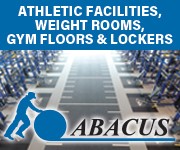Wood is a hygroscopic material which can absorb or lose moisture. Moisture problems such as cupping, crowning, cracking, or buckling occur when the moisture content in the floor planks changes. Wood only changes its dimensions due to changes in moisture. Additionally, even if small changes happen, they are multiplied by the number of floor planks laying side by side across the floor.
When wood floors are installed properly under “wood-friendly” conditions, the installer should have taken measurements of the moisture in the wood floor and should have recorded the ambient conditions in the gymnasium at the time the installation is finished. The measurements should fall into a moisture range for the floor planks of 6-9% and ambient conditions of 35-50% to be considered perfect.
If the conditions and the relationship between moisture and humidity remain the same, the wood floor will also not change; it will not warp, not cup, or start “working on its own.” In addition, the humidity range of 35-50%, which keeps the floor safe, also creates a comfortable climate for the people moving, running, jumping, and exercising in the gym. Equilibrium moisture content and the corresponding relative humidity can be found on the Internet by searching “EMC calculator.”
Ambient Conditions
Changes in wood moisture content are caused by changes in ambient conditions in close proximity to the floor planks. The ambient conditions inside the gym are affected by air from the outside entering the gym through open doors or by infiltration through walls, ceilings, or subfloors. One more issue could be the foundation, if it is allowing moisture to be absorbed through a failing moisture barrier. Since the influences from outside weather conditions are uncontrollable, most gymnasiums have an HVAC system installed to regulate the inside air within the permissible parameters. In case no HVAC system is installed—or the HVAC system fails or is turned off—over time, the floor planks will absorb or loose moisture if exposed to high or low relative humidity.
Low humidity—below 35% —is normally caused by outside cold and dry air in the northern parts of the US or by high desert climate in places like Denver. If the floor is exposed to low humidity for an extended period of time, the planks will split or show gaps. These defects are permanent and irreversible; the structure of the planks is destroyed.
High humidity—above 50%—is normally also caused by outside air during moist summer months or by infiltration of moisture through improperly sealed walls, ceilings, sub floors, or the concrete foundation. If the floor is exposed to high humidity for an extended period of time, the planks will cup, crown, or buckle. Minor changes within the floor can be reversed by getting back to the original moisture content. However, when the structure of the floor planks is compromised, the damage is permanent.
Considering the price of wood floors, it is a worthwhile task to protect the floor’s integrity. Clearly, changes in moisture content have to be prevented or at least limited to small amounts to protect the floor. Detecting changes early allows maintenance personnel to take steps to avoid permanent damage to the floor.
Several tools are recommended for periodically checking the floor and the air surrounding the floors to be alerted early enough to prevent irreversible damage to the floor planks.
Moisture Meters
At the time of installation, the moisture content should be within the range of 6-9%. For drier climates, the value should be close to 6%, for wetter climates, close to 9%. Additionally, the flooring material should have a period of acclimation to local climate conditions before installation After installation, maintenance crews must make sure that the wood floor is not suffering any damage from absorbing or losing moisture. By taking periodic measurements in the same locations, the maintenance crew will accumulate a number of measurements which will indicate if problem areas are developing, hopefully early enough to prevent damage to the floor. If the measurements are always taken in the same locations, changes in moisture will become apparent when readings from previous measuring cycles are compared. The dual-depth meters from Lignomat pinpoint the moisture conditions in the floor planks even better than single-depth meters. The meter takes measurements at two depth levels: close to the surface and deeper down in the same location. These measurements show changes within the floor planks between the wear layer and the core of the planks.
Thermo-Hygrometers
Hand-held thermo-hygrometers allow the maintenance crew to keep an eye on ambient conditions in the gym, independent of other instrumentation available. These tools measure the ambient conditions at the location where the moisture measurements are taken and can indicate a source of potential moisture problems in specific locations.
Combination Moisture Meter and Thermo-Hygrometers
The best tools to use is a combination meter, which measures both relative humidity and wood moisture. Users can easily switch from moisture meter to thermo-hygrometer. These tools make it easy to measure relative humidity and moisture content at the same location.
Data Logger and Moisture Content Tracker
The data logger records moisture content and relative humidity simultaneously. Each set of measurements consists of three moisture content readings and one relative humidity reading. Using this tool is the easiest way to record the moisture in the floor and the relative humidity and review the records remotely.
Whichever measuring tools are chosen, the goal is to keep the floor in stable condition for many years of usage and to be alerted before conditions damage the wood floor irreversibly.










